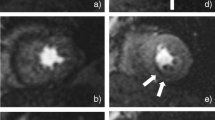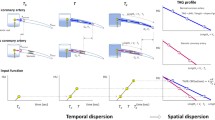Abstract
Purpose
Quantification of myocardial blood flow (MBF) and functional assessment of coronary artery disease (CAD) can be achieved through stress myocardial computed tomography perfusion (stress-CTP). This requires an additional scan after the resting coronary computed tomography angiography (cCTA) and administration of an intravenous stressor. This complex protocol has limited reproducibility and non-negligible side effects for the patient. We aim to mitigate these drawbacks by proposing a computational model able to reproduce MBF maps.
Methods
A computational perfusion model was used to reproduce MBF maps. The model parameters were estimated by using information from cCTA and MBF measured from stress-CTP (MBFCTP) maps. The relative error between the computational MBF under stress conditions (MBFCOMP) and MBFCTP was evaluated to assess the accuracy of the proposed computational model.
Results
Applying our method to 9 patients (4 control subjects without ischemia vs 5 patients with myocardial ischemia), we found an excellent agreement between the values of MBFCOMP and MBFCTP. In all patients, the relative error was below 8% over all the myocardium, with an average-in-space value below 4%.
Conclusion
The results of this pilot work demonstrate the accuracy and reliability of the proposed computational model in reproducing MBF under stress conditions. This consistency test is a preliminary step in the framework of a more ambitious project which is currently under investigation, i.e., the construction of a computational tool able to predict MBF avoiding the stress protocol and potential side effects while reducing radiation exposure.






Similar content being viewed by others
References
Pontone G, Andreini D, Guaricci AI, Baggiano A, Fazzari F, Guglielmo M, et al. Incremental diagnostic value of stress computed tomography myocardial perfusion with whole-heart coverage CT scanner in intermediate- to high-risk symptomatic patients suspected of coronary artery disease. JACC Cardiovasc Imaging. 2019;12:338–49. https://doi.org/10.1016/j.jcmg.2017.10.025.
Pontone G, Andreini D, Guaricci AI, Guglielmo M, Baggiano A, Muscogiuri G, et al. Quantitative vs. qualitative evaluation of static stress computed tomography perfusion to detect haemodynamically significant coronary artery disease. Eur Heart J Cardiovasc Imaging 2018;19:1244–52. doi: https://doi.org/10.1093/ehjci/jey111
Pontone G, Baggiano A, Andreini D, Guaricci AI, Guglielmo M, Muscogiuri G, et al. Diagnostic accuracy of simultaneous evaluation of coronary arteries and myocardial perfusion with single stress cardiac computed tomography acquisition compared to invasive coronary angiography plus invasive fractional flow reserve. Int J Cardiol. 2018;273:263–8. https://doi.org/10.1016/j.ijcard.2018.09.065.
Pontone G, Baggiano A, Andreini D, Guaricci AI, Guglielmo M, Muscogiuri G, et al. Stress computed tomography perfusion versus fractional flow reserve CT derived in suspected coronary artery disease: The PERFECTION Study. JACC Cardiovasc Imaging. 2019;12:1487–97. https://doi.org/10.1016/j.jcmg.2018.08.023.
Pontone G, Baggiano A, Andreini D, Guaricci AI, Guglielmo M, Muscogiuri G, et al. Dynamic stress computed tomography perfusion with a whole-heart coverage scanner in addition to coronary computed tomography angiography and fractional flow reserve computed tomography derived. JACC Cardiovasc Imaging. 2019;12:2460–71. https://doi.org/10.1016/j.jcmg.2019.02.015.
Baggiano A, Fusini L, Del Torto A, Vivona P, Guglielmo M, Muscogiuri G, et al. Sequential strategy including FFRCT plus stress-CTP impacts on management of patients with stable chest pain: the Stress-CTP RIPCORD Study. J Clin Med. 2020;9:2147. https://doi.org/10.3390/jcm9072147.
Alves JR, de Queiroz RAB, Bär M, dos Santos RW. Simulation of the perfusion of contrast agent used in cardiac magnetic resonance: a step toward non-invasive cardiac perfusion quantification. Front Physiol. 2019;10:177. https://doi.org/10.3389/fphys.2019.00177.
Chapelle D, Gerbeau J-F, Sainte-Marie J, Vignon-Clementel IE. A poroelastic model valid in large strains with applications to perfusion in cardiac modeling. Comput Mech. 2009;46(1):91–101. https://doi.org/10.1007/s00466-009-0452-x.
Di Gregorio S, Fedele M, Pontone G, Corno AF, Zunino P, Vergara C, et al. A computational model applied to myocardial perfusion in the human heart: from large coronaries to microvasculature. J Comput Phys. 2021;424:109836. https://doi.org/10.1016/j.jcp.2020.109836.
Lee J, Cookson A, Chabiniok R, Rivolo S, Hyde E, Sinclair M, et al. Multiscale modelling of cardiac perfusion. In: Quarteroni A (eds) Modeling the heart and the circulatory system. MS&A, 2015;14:51–96.
Namani R, Lee LC, Lanir Y, Kaimovitz B, Shavik SM, Kassab GS. Effects of myocardial function and systemic circulation on regional coronary perfusion. J Appl Physiol. 2020;128:1106–22. https://doi.org/10.1152/japplphysiol.00450.2019.
Papamanolis L, Kim HJ, Jaquet C, Sinclair M, Schaap M, Danad I, et al. Myocardial perfusion simulation for coronary artery disease: a coupled patient-specific multiscale model. Ann Biomed Eng. 2021;49:1432–47. https://doi.org/10.1007/s10439-020-02681-z.
So A, Hsieh J, Li YY, Hadway J, Kong HF, Lee TY. Quantitative myocardial perfusion measurement using CT perfusion: a validation study in a porcine model of reperfused acute myocardial infarction. Int J Cardiovasc Imaging. 2012;28:1237–48. https://doi.org/10.1007/s10554-011-9927-x.
Antiga L, Piccinelli M, Botti L, Ene-Iordache B, Remuzzi A, Steinman DA. An image-based modeling framework for patient-specific computational hemodynamics. Med Biol Eng Comput. 2008;46:1097–112. https://doi.org/10.1007/s11517-008-0420-1.
Fedele M. and Quarteroni A. Polygonal surface processing and mesh generation tools for the numerical simulation of the cardiac function. Int J Numer Meth Biomed Engng 2021;e3435. doi: https://doi.org/10.1002/cnm.3435
Michler C, Cookson AN, Chabiniok R, Hyde E, Lee J, Sinclair M, et al. A computationally efficient framework for the simulation of cardiac perfusion using a multi-compartment Darcy porous-media flow model. Int J Numer Method Biomed Eng. 2013;29:217–32. https://doi.org/10.1002/cnm.2520.
Hyde ER, Cookson AN, Lee J, Michler C, Goyal A, Sochi T, et al. Multi-scale parameterisation of a myocardial perfusion model using whole-organ arterial networks. Ann Biomed Eng. 2014;42:797–811. https://doi.org/10.1007/s10439-013-0951-y.
Ponzini R, Vergara C, Redaelli A, Veneziani A. Reliable CFD-based estimation of flow rate in haemodynamics measures. Ultrasound Med Biol. 2006;32:1545–55. https://doi.org/10.1016/j.ultrasmedbio.2006.05.022.
Tezduyar T, Sathe S. Stabilization parameters in SUPG and PSPG formulations. J Comput Appl Mech. 2003;4:71–88.
Arndt D, Bangerth W, Clevenger TC, Davydov V, Fehling M, Garcia-Sanchez D, et al. The deal.II library, Version 9.1. J Numer Math 2019;27:203–13. doi: https://doi.org/10.1515/jnma-2019-0064
Zhang C, A Rogers P, Merkus D, Muller-Delp JM, Tiefenbacher CP, Potter B, et al. Regulation of coronary microvascular resistance in health and disease. In: Tuma RF, Durán WN, Ley K (eds) Microcirculation 2008;521–49.
Kaimovitz B, Lanir Y, Kassab GS. Large-scale 3-D geometric reconstruction of the porcine coronary arterial vasculature based on detailed anatomical data. Ann Biomed Eng. 2005;33:1517–35. https://doi.org/10.1007/s10439-005-7544-3.
SCOT-HEART Investigators, Newby DE, Adamson PD, Berry C, Boon NA, Dweck MR, et al. Coronary CT angiography and 5-year risk of myocardial infarction. N Engl J Med 2018;379:924–33. doi: https://doi.org/10.1056/NEJMoa1805971
Timmis A, Roobottom CA. National Institute for Health and Care Excellence updates the stable chest pain guideline with radical changes to the diagnostic paradigm. Heart. 2017;103:982–6. https://doi.org/10.1136/heartjnl-2015-308341.
Knuuti J, Wijns W, Saraste A, Capodanno D, Barbato E, Funck-Brentano C, et al. 2019 ESC Guidelines for the diagnosis and management of chronic coronary syndromes. Eur Heart J. 2020;41:407–77.
Pontone G, Bertella E, Mushtaq S, Loguercio M, Cortinovis S, Baggiano A, et al. Coronary artery disease: diagnostic accuracy of CT coronary angiography- - a comparison of high and standard spatial resolution scanning. Radiology. 2014;271:688–94. https://doi.org/10.1148/radiol.13130909.
Nørgaard BL, Leipsic J, Gaur S, Seneviratne S, Ko BS, Ito H, et al. Diagnostic performance of noninvasive fractional flow reserve derived from coronary computed tomography angiography in suspected coronary artery disease. J Am Coll Cardiol. 2014;63:1145–55. https://doi.org/10.1016/j.jacc.2013.11.043.
Hlatky MA, De Bruyne B, Pontone G, Patel M, Norgaard BL, Byrne RA, et al. Quality-of-life and economic outcomes of assessing fractional flow reserve with computed tomography angiography: PLATFORM. J Am Coll Cardiol. 2015;66:2315–23. https://doi.org/10.1016/j.jacc.2015.09.051.
Fairbairn TA, Nieman K, Akasaka T, Norgaard BL, Berman DS, Raff G, et al. Real-world clinical utility and impact on clinical decision-making of coronary computed tomography angiography-derived fractional flow reserve: lessons from the ADVANCE Registry. Eur Heart J. 2018;39:3701–11. https://doi.org/10.1093/eurheartj/ehy530.
Author information
Authors and Affiliations
Contributions
Conceptualization: Simone Di Gregorio, Christian Vergara, Gianluca Pontone
Methodology: Simone Di Gregorio, Christian Vergara, Paolo Zunino, Giovanni Montino Pelagi
Formal analysis and investigation: Simone Di Gregorio, Giovanni Montino Pelagi
Writing—original draft preparation: Simone Di Gregorio, Christian Vergara
Writing—review and editing: Simone Di Gregorio, Christian Vergara, Andrea Baggiano, Marco Guglielmo, Laura Fusini, Giuseppe Muscogiuri, Alexia Rossi, Mark G Rabbat, Paolo Zunino, Alfio Quarteroni, Gianluca Pontone
Supervision: Gianluca Pontone, Alfio Quarteroni, Christian Vergara
Corresponding author
Ethics declarations
Ethical approval
Ethical Review Board approval was obtained (R250/15-CCM 262). All procedures performed in studies involving human participants were in accordance with the ethical standards of the institutional and/or national research committee and with the 1964 Helsinki declaration and its later amendments or comparable ethical standards.
Informed consent
Written informed consent was obtained from all subjects (patients) in this study.
Conflict of interest
Pontone G. declared institutional research grant and/or honorarium as speaker from General Electric, Bracco, Heartflow, Boehringer Ingelheim.
Additional information
Publisher’s note
Springer Nature remains neutral with regard to jurisdictional claims in published maps and institutional affiliations.
This article is part of the Topical Collection on Cardiology
Rights and permissions
About this article
Cite this article
Di Gregorio, S., Vergara, C., Pelagi, G.M. et al. Prediction of myocardial blood flow under stress conditions by means of a computational model. Eur J Nucl Med Mol Imaging 49, 1894–1905 (2022). https://doi.org/10.1007/s00259-021-05667-8
Received:
Accepted:
Published:
Issue Date:
DOI: https://doi.org/10.1007/s00259-021-05667-8




